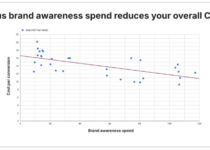How Temporal SEO Drives 86% Higher Conversion Rates
When Bleuet achieved a 529% increase in organic traffic and 7,200% revenue growth within eight months, they weren’t just optimizing for keywords — they were optimizing for time. Their secret weapon? Temporal SEO, which is the approach that aligns content releases with real-time search demand to capture traffic when intent peaks.
In SEO, timing is the difference between competing for scraps and owning entire seasonal markets. As search algorithms become increasingly sophisticated around user intent and context, temporal SEO has evolved from a nice-to-have tactic into a revenue-driving necessity.
Key Takeaways
- Temporal SEO aligns content timing with search demand cycles to capture traffic when user intent peaks, with 35% of Google search results now directly influenced by freshness algorithms in 2025.
- Strategic timing can dramatically boost conversion rates by up to 86% for e-commerce sites, as perfectly timed seasonal content creates optimal alignment between user intent and content relevance.
- Implement a three-phase temporal SEO framework consisting of pre-season preparation (T-180 days), peak season execution (T-30 to T+30 days), and post-season analysis (T+45 days) for systematic optimization.
- Monitor contextual KPIs rather than traditional metrics by tracking peak-season performance against historical benchmarks and measuring competitive displacement during optimal timing windows.
- Temporal SEO creates predictive content opportunities that position brands ahead of emerging trends, enabling proactive market capture rather than reactive optimization against established competitors.
TABLE OF CONTENTS:
Why Temporal SEO Matters More Than Ever in 2025
According to recent analysis, 35% of Google search results are directly shaped by the Freshness algorithm in 2025, meaning over one-third of all search visibility depends on how well your content aligns with temporal signals.
Temporal SEO treats time as a ranking dimension, leveraging three core principles: cyclical optimization around predictable events, real-time response to trending topics, and creating seasonal content that aligns with user intent patterns. The brands winning in search today understand that the right message at the wrong time performs worse than mediocre content published at the perfect moment.
“Right time, right place is essential for great marketing today, and we know the AI powering most search engines have a keen grasp of time already.” – Christopher Penn, Marketing AI Expert
Consider how search behavior has evolved. Users don’t just search for “running shoes”—they search for “best running shoes for winter training” in December or “summer marathon gear” in June. Google’s Query Deserves Freshness (QDF) algorithm actively rewards content that matches these temporal intent patterns, creating massive opportunities for brands that can anticipate and respond to seasonal demand cycles.
The Revenue Impact of Getting Timing Right
The financial implications of temporal SEO extend far beyond traffic metrics. Research shows that targeted, up-to-date seasonal content can boost e-commerce conversion rates by as much as 86%. This dramatic improvement occurs because temporal optimization creates perfect alignment between user intent and content relevance. Users find exactly what they’re looking for at the exact moment they need it.
The success extends beyond e-commerce. ThatWare’s systematic approach to real-time content refresh has enabled them to maintain top rankings for time-sensitive keywords in competitive niches, achieving sustained authority gains that outpace competitors whose content ages quickly. Their strategy centers on implementing content-freshness algorithms that automatically flag decaying pages for rapid rewrites the moment industry changes occur.
| Industry | Temporal SEO Impact | Key Success Metric |
|---|---|---|
| E-commerce Fashion | 529% organic traffic increase | 7,200% revenue growth |
| Healthcare/Medical Tourism | 523% year-over-year growth | 250K+ monthly visits |
| Digital Marketing | Sustained top rankings | Higher engagement rates |
Even regulated industries benefit from temporal strategies. MedPark Hospital’s multilingual content launch calendar generated a 523% year-over-year increase in organic traffic by mapping articles and service pages to pre-planned release windows, and refreshing legacy content 180, 90, and 30 days prior to major campaigns to maintain momentum.
Your Temporal SEO Implementation Framework
Successful temporal SEO requires a systematic approach that balances predictable seasonal patterns with real-time opportunities. The most effective framework operates on three distinct timelines: strategic planning (T-180 days), tactical execution (T-30 to T+30 days), and performance optimization (T+45 days).
Pre-Season Preparation (T-180 Days)
Begin your temporal SEO cycle by conducting comprehensive seasonal audits. Analyze year-over-year Google Analytics data to identify traffic patterns, noting which content performs best during specific periods. This historical analysis reveals the seasonal keywords that drive your highest-converting traffic, helping to predict future demand cycles.
Create content calendars that align with these patterns, but don’t just focus on obvious seasonal events. Look for industry-specific cyclical opportunities. For example, B2B software companies might optimize for “budget planning tools” content in Q4, while fitness brands prepare “New Year resolution” content in November and December.
Peak Season Execution (T-30 to T+30 Days)
During peak periods, monitor SERP volatility and use dynamic on-page elements to optimize performance. Update title tags to include seasonal keywords, refresh meta descriptions with time-sensitive calls to action, and ensure your content hierarchy aligns with evolving search intent. Pages updated within 30 days of peak demand consistently outperform static content.
Implement structured data markup for events, products, and promotions to enable rich snippets that display time-sensitive information directly in search results. E-commerce sites that use an event schema typically see significant improvements in click-through rates during the holiday season.
Post-Season Analysis (T+45 Days)
After each seasonal cycle, conduct a thorough performance analysis against year-over-year benchmarks. Document the content updates that generated the highest ROI, identify missed opportunities, and refine your predictive models for future cycles. This approach helps you capture an increasingly larger market share with each season while continuing to improve your campaign.
Measuring Temporal SEO Success
Traditional SEO metrics often mislead when evaluating temporal strategies. A 30% traffic drop after the holiday season isn’t a failure; it’s expected seasonal normalization. Instead, focus on contextual KPIs that account for cyclical patterns.
Track your peak-season performance against historical benchmarks rather than month-over-month comparisons. Measure conversion rate improvements during optimal timing windows, monitor your ability to capture trending keyword opportunities, and evaluate how quickly your content gains visibility for seasonal terms.
The most successful temporal SEO programs also track competitive displacement. How effectively can you capture market share during peak periods when competitors lag behind with outdated content? Brands that consistently deliver fresh, relevant content build authority that persists beyond individual seasonal cycles.
The Competitive Advantage of Temporal Thinking
Have you created high-quality content optimized for the best-performing keywords, and are still not generating positive SEO results? If you’re not including temporal SEO in your campaign, that could be to blame. Temporal SEO ensures that you post content when demand is at its peak, thereby increasing search visibility and website traffic.
That said, a temporal SEO strategy must balance seasonal demands with opportunities to capture immediately. Start by conducting an audit of your existing campaign, analyzing search pattern data, and forecasting your seasonal demands so you can create content that ranks before competitors even recognize the opportunity exists. During your strategy, refresh existing content and use on-page tactics to maintain your position on the SERPs. After your busy season, measure key KPIs to analyze your results.
In AI search, relevance isn’t solely about authority and thought leadership; it’s about capturing your audience at the right time. Partner with the leading SEO agency that can help you implement these time-sensitive strategies and capitalize on seasonal opportunities.
Ready to stop missing those seasonal gold rush moments and start capturing traffic when your competitors are still planning?
The post How Temporal SEO Drives 86% Higher Conversion Rates appeared first on Single Grain.


